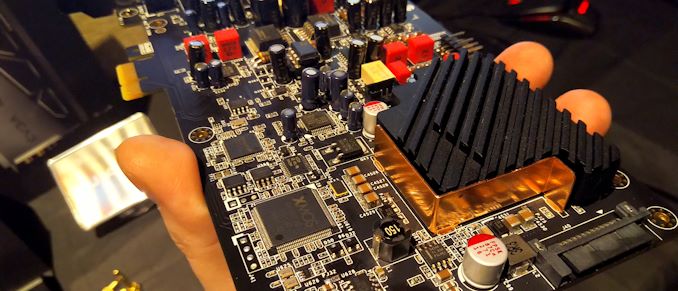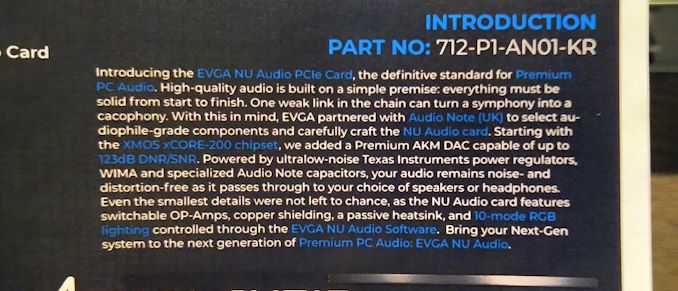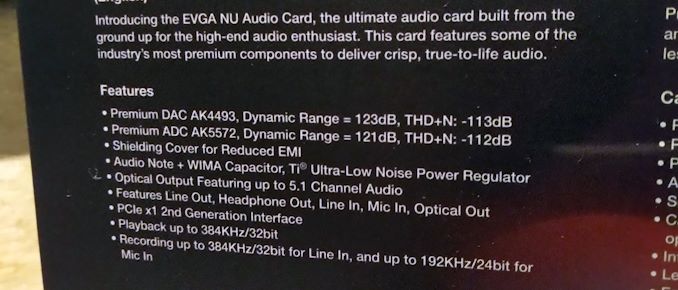EVGA Launches Its First Audio Card, the Nu Audio
by Ian Cutress & Anton Shilov on January 22, 2019 1:00 PM EST- Posted in
- Audio
- EVGA
- Trade Shows
- NU Audio
- CES 2019
- Audio Note

EVGA currently sells a range of products: motherboards, graphics cards, power supplies, cases, and laptops. EVGA has been expanding to other markets for a number of years now, and at CES 2016 we saw the beginnings of a USB audio device due to a collaboration with a professional company called Audio Note. We were impressed at the time, but since then we've not heard much about the project, and had kind of assumed it had been abandoned. But at CES 2019 EVGA introduced the results of the collaboration: its first audio card. This card uses a PCIe to USB controller, making it an internal USB audio product.
EVGA’s Nu Audio card was designed by Audio Note, a UK-based company that develops custom audio solutions. The PCIe 2.0 x1 card implements a PCIe to USB controller to the hardware, and is based on the XMOS xCORE-200 DSP accompanied by Asahi Kasei Microdevices’ (AKM) AK4493 DAC, the AKM AK5572 ADC, and the Cirrus Logic CS5346 ADC. The board uses a silver and gold-plated multilayer PCB with isolated dual ground planes for analogue and digital circuits. Being aimed at users who want a cleaner sound but also better sound support out of their audio outputs, the Nu Audio card uses audio-grade capacitors and resistors that carry Audio Note, Nichicon, WIMA, and Panasonic brands. Besides, it features switchable OP amps as well as a dedicated Maxim amp for headphone volume control.
The Nu Audio card is equipped with two RCA line outs for left and right speakers that can output 384 KHz at 32-bit audio, one output for headphones featuring impedance between 16 and 600 Ohms, an S/PDIF out, a line in supporting 384 KHz at 32-bit audio, and a mic in supporting 192 KHz at 24-bit audio. In addition to traditional analogue and digital outputs, the card supports USB audio class 2.0 enabled by the ASMedia ASM1042 PCIe-to-USB bridge. Meanwhile, to ensure that the board gets enough power, it has a SATA power connector coupled with a multi-stage VRM.
Since EVGA usually targets enthusiasts, its audio card is not only outfitted with a cooling system for heating components, but it is covered by a shroud featuring 10-mode RGB lighting as well as four Audio Reactive Lighting options that match the board’s lighting and audio. The bundled software allows for full EQ tuning, as well as a dynamic response implementation. With the right software, the audio card can support full audiophile formats, such as DSD, and switch between them as required.
EVGA is now currently selling the card, at a price of $249. This is the first in a line of cards, we were told - depending on the feedback of the hardware, the collaboration with Audio Note might extend into a gaming focused design or a more professional audio input/output design.
Related Reading
- EVGA Launches B360 Micro Gaming: Its First Budget Motherboard
- EVGA Releases CLC120 CL11 AIO CPU Cooler: Simple and Affordable
- EVGA Launches SC17 1080 Laptop: Core i7-7820HK, GeForce GTX 1080, TB3
- EVGA Torq X10 Gaming Mouse Review
Source: EVGA
















83 Comments
View All Comments
mode_13h - Saturday, January 26, 2019 - link
> analog volume control! Yes analog volume control.This strikes me as so much audiophile silliness. With 32-bits per sample, there's no reason not to do digital volume control. Even 24-bit would be plenty, for that.
> While I do agree that an outboard DAC would be a better option, this product would cost 2x the price if it's configured that way. No, not 2x, I would say 3x.
And where does the added cost come from? Just the case and powersupply? Since it uses USB for connectivity, I don't imagine the control scheme would change any.
> Anything in the "audiophile" market segment is not a big market, i'm sure EVGA has done their market research.
Well, another pair of RCAs that you could gang together with external cables into balanced outputs would be nice. Not that I'm going to buy it either way, but if I would plug this thing directly into a power amp, I'd want to go balanced.
My current setup uses PC -(toslink)-> DAC -(balanced)-> Preamp/headphone-amp -(balanced)-> powered studio monitors.
My ideal setup would stay digital right up to the speakers. Then, the speakers can use a digital domain cross-over filter, EQ curve, and power amp that are optimally tuned for the speaker:
https://www.genelec.com/key-technologies/smart-act...
Impulses - Tuesday, March 5, 2019 - link
Asus has been making cards that compete with Creative's for years, maybe EVGA just thinks there's room for a third player... I don't remember paying more than $150 for my original Xonar STX but I know they keep updating them and the price points. I don't even use it for anything beyond Dolby Headphone DSP over coax SPIDF at this point, but it's not taking up any valuable room either since I finally went to a single GPU.